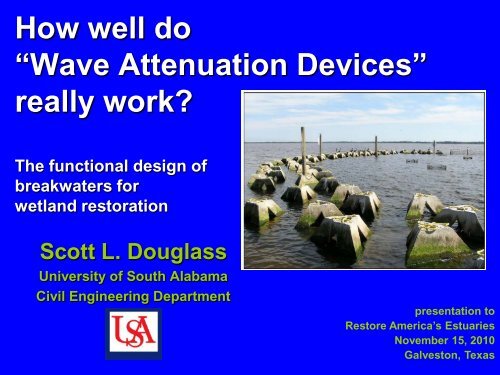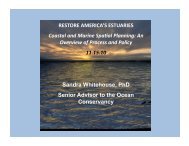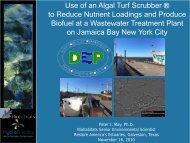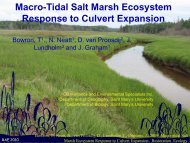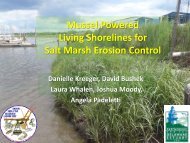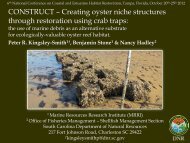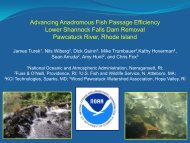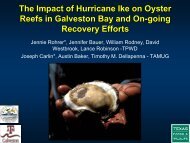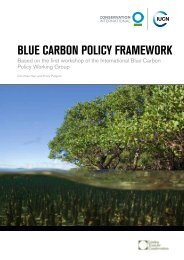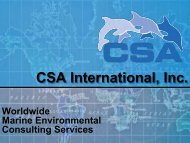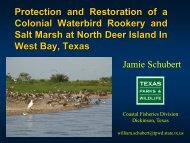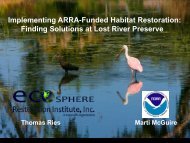Wave Attenuation Devices - Restore America's Estuaries
Wave Attenuation Devices - Restore America's Estuaries
Wave Attenuation Devices - Restore America's Estuaries
- No tags were found...
Create successful ePaper yourself
Turn your PDF publications into a flip-book with our unique Google optimized e-Paper software.
How well do“<strong>Wave</strong> <strong>Attenuation</strong> <strong>Devices</strong>”really work?The functional design ofbreakwaters forwetland restorationScott L. DouglassUniversity of South AlabamaCivil Engineering Departmentpresentation to<strong>Restore</strong> America’s <strong>Estuaries</strong>November 15, 2010Douglass - RAE Nov 15, 2010 1Galveston, Texas
Do “<strong>Wave</strong> <strong>Attenuation</strong> <strong>Devices</strong>” really attenuate waves?How much?Photo from Lamb (2006)Douglass - RAE Nov 15, 2010 2
Little Bay, AlabamaADCNR photosDouglass - RAE Nov 15, 2010 3
The natural shorelinewas erosionalLittle Bay, AlabamaA different, nearby moresheltered site (2002)Douglass - RAE Nov 15, 2010 4
Little Bay, Alabama SiteDouglass - RAE Nov 15, 2010 5
Goal: establish a new,intertidal,S. alterniflora wetlandthat would not beerosional south of theexisting wetlandDouglass - RAE Nov 15, 2010 6
<strong>Wave</strong> climate too energetic for wetlandsRoland and Douglass (2005)Douglass - RAE Nov 15, 20107e
So, it was determined thatsome breakwater wasneeded…Little Bay, Alabama… but how much of abreakwater was needed?Douglass - RAE Nov 15, 2010 8
Texas examplesAnd…“could segmentedoffshore breakwaterswith gaps be used?”Photo from Aspelin (2007)MOREQUESTIONS:Photo from Hauske (2007)Douglass - RAE Nov 15, 2010 9
Holt’s Landing State Park, DEDouglass - RAE Nov 15, 2010 10
And…“could the breakwaters for this site be composedof a segments of rows of commercially available“WAD’s” (concrete units) instead of rock, rubblemoundstructures?Douglass - RAE Nov 15, 2010 11
There are other uses for “Breakwaters”Douglass - RAE Nov 15, 201012
Engineering guidance for the reductionof wave energy by breakwatersDouglass - RAE Nov 15, 201013
<strong>Wave</strong> transmission coefficient= K ttechnology dates back to D-Day!Douglass - RAE Nov 15, 201014
Empirical Data for <strong>Wave</strong> TransmissionThrough and OverRubble-mound StructuresDouglass - RAE Nov 15, 2010 17
Emprical Data and Formulasfor <strong>Wave</strong> Transmissionthrough“<strong>Wave</strong> <strong>Attenuation</strong> <strong>Devices</strong>”Douglass - RAE Nov 15, 2010 18
Do “<strong>Wave</strong> <strong>Attenuation</strong> <strong>Devices</strong>” really attenuate waves?How much? What is the K t for these?Photo from Lamb (2006)Douglass - RAE Nov 15, 2010 19
Univ. of South Alabama wave basin6m by 9m basin1 m deepSinglebulkhead wavegeneratorDouglass - RAE Nov 15, 201020
Scalemodels1:5 scale modelsapex-truncated squarepyramidSix-sided polyhedron orhexahedronDouglass - RAE Nov 15, 201021
Scale models testedDouglass - RAE Nov 15, 201022
1-row configurationDouglass - RAE Nov 15, 201023
2-row: closeDouglass - RAE Nov 15, 201024
2-row: spacedDouglass - RAE Nov 15, 201025
1-row:@ angleDouglass - RAE Nov 15, 201026
2-row:close & @ angleDouglass - RAE Nov 15, 201027
<strong>Wave</strong> gageDouglass - RAE Nov 15, 201028
video ofone testConditions:R c /H=0.15d/L=0.13Results:K t = 0.76Douglass - RAE Nov 15, 201029
Testing procedures•Reported K t based on Hwith and without structures•“burst” methodDouglass - RAE Nov 15, 201030
Laboratory Tests of <strong>Wave</strong>Transmission though “<strong>Wave</strong><strong>Attenuation</strong> <strong>Devices</strong>”Results:40% < K t < 90%•Emergence•ConfigurationDouglass - RAE Nov 15, 2010 31
1.0WAD transmission test results0.80.6Results:WAD results0.40.2rubble-mound -van der Meer0.0K tRelative Crest Height - R c /H-2 -1 0 1 2 3Douglass - RAE Nov 15, 2010 32
Results:•WADs doattenuate wavesLaboratory Tests of <strong>Wave</strong>Transmission though “<strong>Wave</strong><strong>Attenuation</strong> <strong>Devices</strong>”•2 to 5 times the H-transmissionthrough rockstructures of thesame heightDouglass - RAE Nov 15, 2010 33
Presently ongoing Laboratory Tests of <strong>Wave</strong>Transmission properties of oyster shell reefsDr. Bret WebbCivil Engrg DeptUniv. South AlabamaDouglass - RAE Nov 15, 2010 34
Implications of model tests for design ofLittle Bay, Alabama project:•Taller WADsADCNR photo•2-row close configurationADCNR photoDouglass - RAE Nov 15, 2010 35
Gaps left in 2-row WAD breakwaters – under constructionADCNR photoDouglass - RAE Nov 15, 2010 36
This is not an endorsement of WAD’sADCNR photoOctober 27, 2010 photosDouglass - RAE Nov 15, 2010 37
Holt’s Landing State Park, DEDouglass - RAE Nov 15, 2010 38
Functional design of breakwaters forwetland creation:•Is a breakwater needed?•Site-specific evaluationA. Existing shoreline and wave climateB. Roland & Douglass (2005) - wave tolerance•What is the smallest breakwater system needed?•Minimize design with existing coastal engineering toolsforA. TransmissionB. DiffractionDouglass - RAE Nov 15, 2010 39
Questions?Contact Info:Scott L. DouglassCivil Engineering DepartmentUniversity of South Alabamasdouglass@usouthal.edu251-510-2903Douglass - RAE Nov 15, 2010 40


